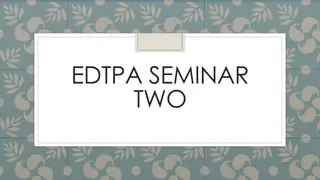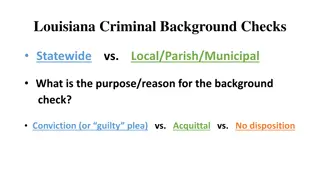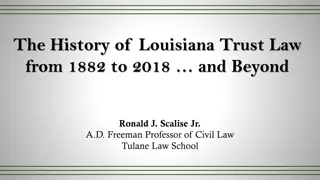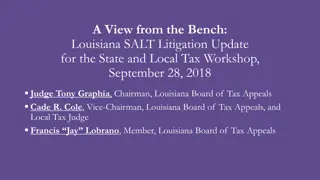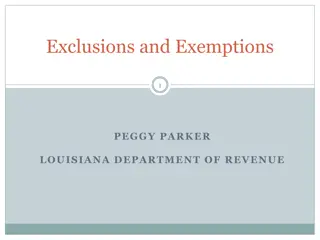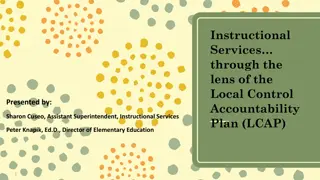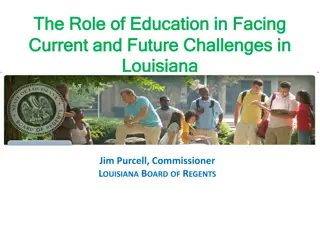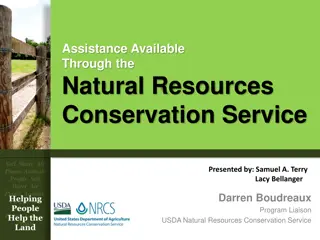
Louisiana Department of Education Instructional Supports Overview
Educators will gain awareness of the instructional supports provided by the Louisiana Department of Education for the 2014-2015 school year. The presentation covers resources, release calendar, and an online framework for English language arts instruction.
Download Presentation

Please find below an Image/Link to download the presentation.
The content on the website is provided AS IS for your information and personal use only. It may not be sold, licensed, or shared on other websites without obtaining consent from the author. If you encounter any issues during the download, it is possible that the publisher has removed the file from their server.
You are allowed to download the files provided on this website for personal or commercial use, subject to the condition that they are used lawfully. All files are the property of their respective owners.
The content on the website is provided AS IS for your information and personal use only. It may not be sold, licensed, or shared on other websites without obtaining consent from the author.
E N D
Presentation Transcript
Connect with us and ask questions during this presentation: Via e-mail at LouisianaTeacherLeaders@la.gov Via Twitter #TeacherLeaders LouisianaBelieves. 2
Who is on our Teacher Leader panel? Angelle Lailhengue, St. Bernard Parish Christina Johnson, Jefferson Parish Shelia Banks, Jefferson Parish LouisianaBelieves. 3
Objective Educators will be aware of the instructional supports provided by the Louisiana Department of Education for the 2014- 2015 school year LouisianaBelieves. 4
LDOE Release Calendar Date Resources Grades 6-8 ELA and math guidebooks List of K-12 ELA texts included in the ELA unit plans (for purchasing) High school ELA and math guidebooks Grades 3-5 ELA and math guidebooks ELA interactive framework PARCC assessment guides, sample items, and additional resources SLT guidance (including new 2014-15 samples) LEAP, iLEAP, End-of-Course exams, ACT, EXPLORE, & PLAN results (late May) Grades K-2 ELA and math guidebooks Teacher Leader Institute in New Orleans March April May June
Online Framework INSTRUCTIONAL FRAMEWORK In English language arts (ELA), students must learnto read, understand, and write and speak about grade-level texts independently.To dothis, teachers must select appropriate texts and use those texts so students meet the standards, as demonstrated through ongoing assessments. To support students in developingindependence with readingand communicating about complex texts, teachersshould incorporate the followinginterconnected components into their instruction. Click here8to locate additional information aboutthis interactive framework. Whole-Class Instruction This time is for grade level instruction. Regardlessof a student s readinglevel, exposure to grade-level texts supports language andcomprehension developmentnecessary for continual readinggrowth. This plan presentssamplewhole-class tasks torepresent how standardsmight bemet at thisgrade level. Small-Group Reading This time is for supporting student needs that cannotbe met duringwhole-classinstruction. Teachers might provide: 1. intervention for students below grade level using textsattheirreadinglevel, 2. instruction for differentlearnersusing grade level texts to supportwhole-classinstruction, 3. extension for advancedreadersusing challengingtexts. Small-Group Writing Most writing instruction is likely to occur duringwhole-class time. Thistime is for supporting student needs thatcannot be met duringwhole-classinstruction. Teachers mightprovide: 1. intervention for students below grade level, 2. instruction for differentlearnersto supportwhole-classinstruction and meetgrade-levelwriting standards, 3. extension for advancedwriters. Independent Reading This time is for increasingthe volume andrange of readingthat cannot be achieved through other instruction butis necessary forstudent growth. Teacherscan: 1. supportgrowingreadingability by allowingstudents to read books at theirreadinglevel. 2. encouragereadingenjoymentand build readingstamina andperseverance by allowingstudents to select their own texts in addition to teacher-selected texts. 8http://www.louisianabelieves.com/resources/classroom-support-toolbox/teacher-support-toolbox/lesson-assessment-planning-resources 6 English Language Arts,Grade 6: Hatchet
Sample ELA Unit Plan Grade 6 ELA Provides teachers with assessment tasks, daily instructional tasks, and support in delivering instruction Can be adapted; not required
UNIT: HATCHET ANCHOR TEXT Hatchet, Gary Paulsen (Literary) UNIT FOCUS This unit teachesstudentsabout survival in the face of grave danger and overwhelmingodds. Students willevaluate survival storiesto learn aboutthe importanceof positivethinking, slowingdownto thinkclearly, problemsolving, and constantvigilance when facing any situation,especially a life threateningone. They will alsostudycharacters in literatureto learn aboutthe struggleof manversus nature and the life lessonswe canlearn from others survival situations. RELATEDTEXTS LiteraryTexts (Fiction) In Whichthe AutumnProvidesFoodand Loneliness and In Which We All Learn AboutHalloween from MySide of the Mountain, Jean CraigheadGeorge (Note: This excerptcan be found in some grade 5 basals.) Chapters1-2, 4, and 8-9 from The River, Gary Paulsen Excerpt1 from Julie of theWolves, Jean Craighead George Text Use: Characters,conflict,theme, and comparingand contrastingdifferent texts Reading: RL.6.1, RL.6.2, RL.6.3, RL.6.4, RL.6.5, RL.6.6, RL.6.7, RL.6.9, RL.6.10; RI.6.1, RI.6.2, RI.6.3, RI.6.4, RI.6.6, RI.6.8, RI.6.9, RI.6.10 Writing: W.6.1a-d;W.6.2a-f, W.6.3a-e,W.6.4, W.6.5,W.6.7, W.6.8, W.6.9a-b, W.6.10 Informational Texts(Nonfiction) WhatWouldPeterDo? from OutdoorSafe Inc., Peter Kummerfelt Help Me make it Through the Night Surviving a Wilderness Emergency from New York State Conservationist, Kelly Stang (April 2012) The Practiceof SlowingDown from This I Believe, PhilPowers Survival by the Numbers from OutdoorSafe Inc., Peter Kummerfelt Your Story: Are You a Survivor? from National Geographic The 25 Most Incredible Survival Storiesof All Time from Outdoorlife.com,Tim MacWelch Speaking and Listening: SL.6.1a-d, SL.6.2,SL.6.3, SL.6.4, SL.6.5, SL.6.6 Language: L.6.1a-e,L.6.2a-b, L.6.3a-b, L.6.4a, L.6.5a-c,L.6.6 CONTENTS Page 1: Text Setand Unit Focus Page 2: Unit ContentOverview Pages3-5: SummativeUnitAssessments: CulminatingWriting Task, Cold-Read Assessmentand ExtensionTask Page 6: ELA Instructional Framework Pages7-16: Text Sequence and Use for Whole-Class Instruction Non-print Texts (Fiction or Nonfiction) (e.g., Media, Video, Film, Music, Art, Graphics) A Cry in the Wild,Mark Griffins (1990) Snow Fall:The Avalanche at Tunnel Creek from The New York Times, John Branch (Website) 1Excerpt is pending permission: http://www.parcconline.org/samples/english-language-artsliteracy/grade-6-elaliteracy 8 English Language Arts,Grade 6: Hatchet
Hatchet Unit Overview Daily Tasks Unit Focus SummativeUnit Assessments Daily instruction helps students read and understand text and express that understanding. A culminating writing task: Topic:Physicaland emotional survival Themes:Evaluatesurvival stories to learn aboutthe importanceof positivethinking, slowingdownto think clearly, problemsolving, and constant vigilance Text Use: Characters,conflict, theme, and comparingand contrastingdifferent texts Evaluatecharacterchanges Compareand contrast different textsin termsof their approaches to the topicof survival Lesson1 Hatchetchapters1-2 (sample tasks) Lesson2 Hatchetchapters3-4 Lesson3 Hatchetchapter5 and What WouldPeter Do? (sampletasks) Lesson4 Hatchetchapters6-8 and Help Me Make it Throughthe Night (sample tasks) A cold-read task: Read and understandcomplex texts Write in response to text Lesson5 Hatchetchapters9-10 Lesson6 Hatchetchapters11-13 Lesson7 In Which theAutumnProvidesFoodand Loneliness and In WhichWe All Learn About Halloween from MySide of the Mountain An extension task: Collegial conversations Conducta shortresearch project about the topicof survival Read and gatherinformationfrom multiple and varied sources Lesson8 Hatchetchapters14-15 (sample tasks) Lesson9 Hatchetchapters16-18 (sample tasks) Lesson10 Hatchet chapters 19 and ThePracticeof SlowingDown Evaluateand present claims Lesson11 A Cry inthe Wild Lesson12 The River chapters 1-2, 4, 8-9 Lesson13 Survival by theNumbers (writingtask) Lesson14 Julie and the Wolves (cold-readtask) Lesson15 The 25 Most Incredible Survival Storiesof All Time and Your Story: Are You a Survivor? (extension task) Lesson16 Snow Fall:The Avalanche at Tunnel Creek 9 English Language Arts,Grade 6: Hatchet
SUMMATIVE UNIT ASSESSMENTS CULMINATING WRITINGTASK2 Selectan event from Hatchet and identify Brian ssteps for survival. Afterreading Survival by theNumbers from OutdoorSafe Inc. by Peter Kummerfelt, compare Brian s actions against the tips included in the article. Whatdid Brian do to aid or hinder his survival? Then write a multiparagraph report explaining how Brianwas successful and/or couldhave improvedhis situationif he had followedthesteps provided inthe articlecase studies. Conclude the report by determiningthe instructional value of Hatchet doesit represent useful survivaltips similar to Survival bythe Numbers ? (RL.6.3, RL.6.9, W.6.10) TeacherNote: Student essays should introduce and explainBrian s approachto survival using relevantevidence from Hatchetand theinformational article. (W.6.2a,b; W.6.9a-b)Student essays should use appropriate transitions,precise and grade appropriatelanguage, a varietyof sentence patterns for meaning, interest, and style, and provide a relevant conclusion that examines the instructional value of Brian sstory.(W.6.2c, d, e, f; W.6.4; L.6.3a-b, L.6.6) The essay should demonstrate proper grammar and usage (pronouns in theirproper case, with clear antecedents, and in appropriate number and person),punctuation, and spelling. (L.6.1a, c, d; L.6.2b) Use peer and teacher conferencing in the process of developingthe essay. (W.6.5) A model of a similar report is available here3. UNIT FOCUS UNIT ASSESSMENT DAILYTASKS What shouldstudentslearn from the texts? What showsstudents have learnedit? Which tasks helps students learn it? Topic: Physicaland emotional survival Themes:Evaluatesurvivalstories to learn about the importanceof positivethinking, slowingdownto think clearly, problem solving, andconstantvigilance Text Use: Characters,conflict,theme, and comparingand contrastingdifferent texts This taskassesses: Read and understandtext: Evaluatingcharacterchanges Comparingand contrastingdifferent texts in termsof theirapproaches to the topicof survival Lesson1 Lesson2 Lesson3 (sampletasksincluded) Lesson4 (sampletasksincluded) Lesson10 Express understanding of text: Lesson3 (sampletasksincluded) Lesson4 (sampletasksincluded) Lesson8 (sampletasksincluded) Lesson13 2 Culminating Writing Task: Students express their final understanding of the anchor text and demonstrate meeting the expectations of the standards through a written essay. 3 http://www.artofmanliness.com/2010/03/11/10-wilderness-survival-lessons-from-hatchet/ 10 English Language Arts,Grade 6: Hatchet
COLD-READTASK4 Read the excerpt from Julieof theWolves by Jean Craighead George independentlyand answer a combinationof multiple-choiceand constructed-response questions5 aboutthe textusing evidence for all answers. PARCC assessment Itemsfor thesepassagesare available here6. SamplePARCC question: In the passage,the authordeveloped a strongcharacter namedMiyax.Think about Miyax and the details the authorused to create that character. The passage ends with Miyax waitingfor the blackwolf to look at her. Write an original storyto continue where the passageended. In yourstory, be sure to use whatyou have learnedabout the characterMiyaxas you tellwhathappens to her next. (RL.6.1, RL.6.3, W.6.3a-e, W.6.4, L.6.1a-e,L.6.2a-b,L.6.3a-b) UNIT FOCUS UNIT ASSESSMENT DAILYTASKS What shouldstudentslearn from the texts? What showsstudents have learnedit? Which tasks helps students learn it? Topic: Physicaland emotional survival Themes:Evaluatesurvivalstories to learn about the importanceof positivethinking, slowingdownto think clearly, problem solving, andconstantvigilance Text Use: Characters, conflict, theme, and comparingand contrastingdifferent texts This taskfocuseson: Read and understandtext: Reading and understandingcomplextexts Writingin responseto text Lesson3 (sampletasksincluded) Lesson4 (sampletasksincluded) Lesson10 Express understanding of text: Lesson3 (sampletasksincluded) Lesson4 (sampletasksincluded) Lesson14 (use thistask) 4Cold-Read Assessment: Students read a text or texts independently and answer a series of multiple-choice and constructed-response questions. While the text(s) relate to the unit focus, the text(s) have been taught during the unit. Additional assessment guidance is available at http://www.louisianabelieves.com/resources/classroom-support-toolbox/teacher-support-toolbox/end-of- year- assessments. 5 Ensurethat students have accessto the complete texts as they are testing. 6http://parcconline.org/samples/english-language-artsliteracy/grade-6-elaliteracy 11 English Language Arts,Grade 6: Hatchet
EXTENSIONTASK7 After reading and discussing Your Story: Are You a Survivor? as a class, divide the class into research groups and presentthe The 25 Most Incredible Survival Storiesof All Time from Outdoorlife.com. Haveeach group selecta differentsurvival storyto investigatefurther. (Note: Survival storiesaresometimes graphic, so depending on the maturity of thestudents,consider limitingthelist from 25 to10.) Research the detailsof the story in groups, drawing on print and digital sources(assessingthecredibility of eachsource),to identifythe main actionor charactertraitthat resultedin survival.(W.6.7, W.6.8, SL.6.1b)Create a multimedia presentationthat presents: a summary of the story, a statementof the claim (e,g., The maincharacter trait that resulted in this person s survivalwas preparedness ), evidence (e.g., appropriatepictures, maps,videos,quotations) and a logical explanationfor why thatone actionor characteristicwas selected, and basic bibliographic informationfor sources.(W.6.1a-b,W.6.8, W.6.9b, SL.6.2, SL.6.4, SL.6.5) Have studentsevaluate each group s content, presentationstyle, and use of evidence, distinguishingclaimsthat are supportedwithtextual evidence from claims that are not.Determineas a classwhat madepresentationseffective basedon evidencefrom individualevaluations. (SL.6.1a, d; SL.6.3; SL.6.6) TeacherNote: The presentationsshould use grade appropriate words and phrasesand formal style, proper grammar and usage (pronounsin theirproper case, with clear antecedents,and in appropriate number and person),punctuation, and spelling. (W.6.1c, d; L.6.1a, c, d; L.6.2a-b,L.6.2a-b, L.6.6) UNIT FOCUS UNIT ASSESSMENT DAILYTASKS What shouldstudentslearn from the texts? What showsstudents have learnedit? What tasks helpsstudentslearn it? Topic: Physicaland emotional survival Themes:Evaluatesurvivalstories to learn about the importanceof positivethinking, slowingdownto think clearly, problem solving, andconstantvigilance Text Use: Characters,conflict,theme, and comparingand contrastingdifferent texts This taskfocuseson: Read and understandthe text: Collegial conversations Conductinga short researchproject about the topicof survival Reading and gatheringinformationfrom multiple and varied sources Evaluatingand presentingclaims Lesson3 (sampletasksincluded) Lesson4 (sampletasksincluded) Lesson7 Lesson10 Express understanding of text: Lesson4 (sampletasksincluded) Lesson9 (sampletasksincluded) Lesson13 Lesson15 (use thistask) 7Extension Task: Students connect and extend their knowledge learned through texts in the unit to engage in research or writing. The research extension task extends the conceptsstudied in the set so students can gain more information about conceptsor topics that interest them. The writing extension task either connects several of the texts together or is narrative task related to the unit focus. 5 English Language Arts,Grade 6: Hatchet
TEXT SEQUENCE AND SAMPLE WHOLE-CLASS TASKS TEXT SEQUENCE TEXT USE LESSON 19: TEXT DESCRIPTION: The openingchapterintroduces the maincharacter, Brian Robeson. Brian is flying as the sole passenger in a smallplane flying northto Canada to visit his father when the pilot suffers a fatalheart attack. On his belt Brian has the partinggift his mothergave him, a hatchet. Once Brian realizes the pilot has died in Chapter 2, he tries to get help utilizingthe radio.By the end of chapter 2 Brian realizes he is going to crash. Brian nervouslystartsthe plane on its descent. Chapters1-2 of Hatchet, Gary Paulsen TEXT FOCUS: In thisunit students explore characterand theme as it appliesto the topicof survival. Thesechapters introduce studentstothe maincharacterBrian. These chapters prepare students to begin exploring Brian s character and understandthe challengingsituationhe finds himselfin. Readingand summarizingthese chapterswill help students evaluate Brian scharacterand decisionmakingwith later chapters and texts. (RL.6.2, RL.6.3) MODEL TASKS Note for Small-GroupReading: Teachers may chooseto engage strugglingreaders with additional readings of whole-class textseither before or after the texts have been read as a wholeclass. Thiswill provideextra timefor studentsto process the informationand receive additionalsupportthroughbasic comprehension questions.This can help students be more prepared to participate in the whole-classdiscussion. Several chaptersin Hatchet(i.e., Chapters 2, 3, 11, 14, and 19) include sentencesthatvary in sentence lengthand patterns (i.e.,use and repetitionof single-wordsentences or the use of dashes) and dialogue.As such, these passages are useful for working with strugglingreaders on fluencyand reading with expression10. A rubric for assessingreading fluencyis availablehere11. Techniques for how to address fluency can be found withthe ELA Instructional Framework12. LESSON 2: TEXT DESCRIPTION: In Chapters3 and 4, Brian flies the plane into a lake realizing that is the only way to survive the plane's crash. Brian fights his way out of theplane to the surfaceof the lake. He emerges exhaustedand passesout. While asleep Brian remembers the secret thathe believesled to his parents divorce.After waking Brian realizes he is fortunate to be alive but also realizes he is facing some big challenges. Chapters3-4 of Hatchet, Gary Paulsen 9Note: One lesson does not equal one day. Teachersshould determine how long to takeon a given lesson. This will depend on eachunique class. 10 For example, use an oral-assisted reading technique (e.g., phase-cued text lessons, reading while listening to a fluent reading of the same text by another reader (either live or recorded), or paired reading in which both readers read the same text aloud) while students read a targeted passage (e.g., the plane crashin Chapter 2) several times. The goal should be for students to fluently read the passages aloud with expression. If this work is done in advance of reading one of the chaptersasa whole class, one or moreof the students who have demonstrated fluency couldread one of the chaptersaloud as the class followsalong. 11http://www.timrasinski.com/presentations/multidimensional_fluency_rubric_4_factors.pdf 12http://www.louisianabelieves.com/resources/classroom-support-toolbox/teacher-support-toolbox/lesson-assessment-planning-resources/small-group-reading 7 English Language Arts,Grade 6: Hatchet
Sample Math Task Grade 7 Math Provides teachers with a great deal of support in delivering instruction including exemplar responses Can be adapted; not required
Mathematics Grade 7 Instructional Task Addingand SubtractingRational NumbersInstructional Task Overview This instructionaltask requiresstudents to use addition and subtraction of rational numbers to create a budget for a school club. Standards Apply and extend previous understandings of operationswith fractions to add,subtract, multiply, and divide rationalnumbers. 7.NS.A.1 Apply and extend previous understandingsof addition and subtraction to add and subtract rational numbers; represent addition and subtractionon a horizontal or vertical number line diagram. a. Describe situationsin which opposite quantitiescombine to make 0. For example, ahydrogen atom has 0 charge because its two constituents are oppositely charged. b. Understand p + q as the number located a distance|q| from p, in the positive or negative direction depending on whether q ispositive or negative. Show that a number and its opposite have a sum of 0 (are additive inverses). Interpret sums of rational numbers by describing real-world contexts. c. Understand subtraction of rational numbers asadding the additive inverse, p q = p + ( q). Show that the distance between two rational numbers on the number line isthe absolute value of their difference, and apply thisprinciple in real-world contexts. d. Apply propertiesof operationsasstrategies to add and subtract rational numbers. 7.NS.A.3 Solve real-world and mathematical problemsinvolving the four operationswith rational numbers. Prior to theTask Standards Preparation: The material in the chart below illustratesthe standardsand sample tasksthat are pre-requisitesfor student success with thistask s standards. 7.NS.A.1 6.NS.C.7c a. 3. http://www.illustrativemathematics .org/7.NS.A.1 Grade Level Standards The following standards will preparethem: Itemsto Check for Task Readiness: Sample RemediationItems: 5.NF.A.1 1. http://www.illustrativemathematics.org/5. NF.A.1 http://www.illustrativemathematics.org/6. NS.C.5 http://learnzillion.com/lessonsets/411- add-and-subtract-rational- numbers- represent-addition-and-subtraction-on-a- horizontal-or- vertical-number-line-diagram http://learnzillion.com/lessonsets/596- adding-and-subtracting-rational- numbers- using-distance-absolute-value-and- opposites 1. a. 6.NS.C.5 2. 2. 6.NS.C.6a 3. 4. 1. Your class is considering going on a field trip to a skating ring. The admission fee is $12per person. You have 25 students in your class. How much will it cost for your class to enter the skating ring? a. $300 http://www.illustrativemathematics .org/7.NS.A.3 7.NS.A.3 4.OA.A.3 1. http://www.illustrativemathematics.org/4. OA.A.3 http://www.illustrativemathematics.org/6. NS.B.3 http://learnzillion.com/lessons/1150-use- addition-and-subtraction-to- solve- realworld-problems-involving-decimals 6.NS.B.3 2. 3. 2.
Mathematics Grade 7 Instructional Task Realworld preparation: The followingquestions willprepare students for some of the real worldcomponents of thistask: 1. What is a budget? a. Thisquestion is designed to make sure that students understand the purpose of thistask. They need to figure out a plan to track how much money is deposited and how much money is spent to ensure that the account alwayshas money. 2. What is an account? a. Some students may be unfamiliar with accounts and using banks. You may need to explain that a bank is where you can bring money. The bank holds the money in an account until you are ready to spend it. 3. What is a balance? a. Students may be unfamiliar with banking terminology. A balanceis the amount of money in your account. 4. What is the difference between a withdrawal and a deposit? a. Students may confuse these terms. A deposit is putting money into an account,and a withdrawal is taking money out of an account During the Task: Students may struggle with creating a monthly statement. You can scaffold this task for them using the three months in part one. Have students create monthly statements for September, October, and November. This will help students practice the process of creating a monthly statement before they have to start making decisionsabouthow to make and spend money. During the task, asyou circulate around the room look for groupswho may only be adding in unrealistic numbers for their fundraisers. For example, students may only addin $25 for a car wash fundraiser. Ask students guidingquestionslike the following: 1. If you made $25 at your car wash, how many carsdid you wash? a. 5 carsat $5 each 2. Would you have a car wash if you only were only going to was 5 carsall day? a. Students at thispoint should discussa car wash and about how many carsthey might expect to wash. After theTask: Thistask shows students how math is useful in their own lives. Encouragestudents to think of ways creating a budget might be useful in their own lives. Students may mention creating budgets for clubsor their own personal money.
Mathematics Grade 7 Instructional Task Student InstructionalTask Your group has been selected as the officersfor your school s Junior BetaClub. One of your tasks as theexecutive committee is to track all money deposited into the account as wellas all moneyspent during the year and create a budget for the remainder of the year. At thebeginning of September,the balancein the accountwas$253.24. 1. Beloware listedthe activitiesthe club spent money on or collectedmoney for: Sept 1 Sept 30 Dues: 25members at$5each Oct 1 Oct 31 Gardening materials: $ 124.98 Bake sale: $205.50 Nov 1 Nov 30 Supplies for Thanksgiving baskets: $ 40.43 Induction ceremony: $ 100.32 a.Using thetable above, create a number line to representthe amountof money added to the accountduring this three-monthperiod. b. Usingthe table above, createa numberline to representthe amountof money spentduring this three-month period. c.How muchmoney is in the account at the end of November? Show two different waysto find the balance of the account. 2. Thisyear the club alsovotedto include some fun activitiesthroughouttheyear and an end-of-yeartrip to celebrate the club s success.Below isa list of the suggestedactivitiesand fundraisers. Fun Activities Bowling: $60 per lane (up to 6 people per lane) Skating: $12 per person LaserTag: $15 per person Waterpark: $50 per person Zoo visit: $12 per student; $17.50 per adult Fundraisers Candy sale: $60 per member Wrapping paper: $50 per member Holiday wreaths:$65 per member Car wash: $5 per car Dress down day: $1 per student a.Create a monthly budgetfor the remainderof theyear. In your budget,you will proposewhich fun activity or activitiesyour club shouldpursue. You will also propose which fundraisersyour club shoulduse to raise the money to finish the year. Keep the followingpoints in mind. Begin withDec 1 Dec 31 and end withMay 1 May31. Show the balanceat the beginningof eachmonth (use the ending balancefrom November as the beginning balancefor December). Show any proposedexpensesfor themonth as well as any proposed fundraisers. Budget $75 per month for suppliesfor service projects. The club mustalso attendthe Louisiana Jr. Beta Club Conventionin Lafayette,LA in May. The costof thetrip for the conventionis $1,500. This includestransportationand hotel rooms. Include at leastone Fun Activity from the list above. The balanceat the end of May shouldat least $250 to begin the next schoolyear. Your budgetshouldincludea month by monthstatement as well as a short narrativeexplaining why you chosecertain activitiesand fundraisers. Each monthlystatement shouldshow how you calculated the balance at the end each month.
Mathematics Grade 7 Instructional Task Instructional Task Exemplar Response Your grouphas been selected as the officersfor your school s Junior BetaClub. One of your tasks as theexecutive committee is to track all money deposited into the account as wellas all moneyspent during the year and create a budget for the remainder of the year. At thebeginningof September,the balancein the accountwas$253.24. 1. Beloware listedthe activitiesthe club spent money on or collectedmoney for: Sept 1 Sept 30 Dues: 25members at$5each Oct 1 Oct 31 Gardening materials: $ 124.98 Bake sale: $205.50 Nov 1 Nov 30 Supplies for Thanksgiving baskets: $ 40.43 Induction ceremony: $ 100.32 Students may have different number lines for parts a and b as they may not use the beginning balance. The problem asks to show the amount added or spent; studentsmay choose tostartat zero. Theremay also be differentmethods shown in part c.
Mathematics Grade 7 Instructional Task 2. Thisyear the club alsovotedto include some fun activitiesthroughouttheyear and an end-of-yeartrip to celebrate the club s success.Below isa list of the suggestedactivitiesand fundraisers. Fun Activities Bowling: $60 per lane (up to 6 people per lane) Skating: $12 per person LaserTag: $15 per person Waterpark: $50 per person Zoo visit: $12 per student; $17.50 per adult Fundraisers Candy sale: $60 per member Wrapping paper: $50 per member Holiday wreaths:$65 permember Car wash: $5 per car Dress down day: $1 per student a.Create a monthly budget for the remainderof theyear. In your budget,you will proposewhich fun activity or activitiesyour club shouldpursue. You will also propose which fundraisersyour club shoulduse to raise the money to finish the year. Keep the followingpoints in mind. Begin withDec 1 Dec 31 and end withMay 1 May31. Show the balanceat the beginningof eachmonth (use the ending balancefrom November as the beginning balance for December) Show any proposedexpensesfor themonth as well as any proposed fundraisers. Budget $75 per month for suppliesfor service projects. The club mustalso attendthe Louisiana Jr. Beta Club Conventionin Lafayette,LA in May. The costof thetrip for the conventionis $1,500. This includestransportationand hotel rooms. Include at leastone Fun Activity from the list above. The balanceat the end of May shouldat least $250 to begin the next schoolyear. Your budgetshouldincludea month by monthstatement as well as a short narrativeexplaining why you chosecertain activitiesand fundraisers. Each monthlystatement shouldshow how you calculated the balance at the end each month. In your narrative, be sure to explainhow you determined which fundraisersto choose,which activity to choose, and when to conductcertain fundraisers. Also,be sure state how muchmoneywill be remainingat the end of May. Be prepared to share your budget withthe class. This portionof thetaskwill take on many different looks. Students havemultipleoptions to fulfill the requirements listed above. They will need to make some assumptionsabout the number of chaperonesneeded for the activitiesthey may wish to propose.They mayalso need to make some assumptions aboutthe fundraisers,specifically the number of cars they would need to wash and how many studentsmight buy a dressdown day pass. Students could researchthe rules in their school/district and past dress down eventsto attempt to determinevalues that make sensewiththis problem. At minimum, studentsmust include fundraisersto cover $1950 for the service projectsuppliesand convention. Additional fundraiserswould be needed to cover the cost of the activity they chose to propose.
Math Scaffolding Guides Shows the connections and scaffolding between the math standards Ideal for supporting struggling students
Standard Scaffolding The purpose of this document is to show the connections and scaffolding between standards. If a student isstrugglingwith a standard,this document helpsa teacherquickly identify the pre-requisitestandard needed. This allows a teacher to do discreetremediationto help students practiceon-grade level content faster. This is a clear illustrationof the coherencefound in the math standards. 7th Gradestandards taught before (scaffolded) Previous Grade Standards 7th Gradestandards taught concurrently 7th GradeStandard 7.RP.A.1 Compute unit ratesassociatedwith ratiosof fractions,including ratiosof lengths, areas and otherquantitiesmeasuredin like or different units. For example, if a personwalks 1/2 mile in each 1/4 hour, compute the unit rate as thecomplex fraction1/2/1/4 miles per hour,equivalently2 miles per hour. 7.RP.A.2 Recognize and represent proportional relationships between quantities. a. Decidewhether two quantitiesare in a proportional relationship,e.g., by testingfor equivalentratios in a table or graphing on a coordinate plane and observingwhether the graph is a straight line through the origin. b. Identify the constantof proportionality(unit rate) in tables, graphs, equations,diagrams, and verbal descriptionsof proportional relationships. c. Represent proportional relationships by equations.For example, if totalcost t is proportional to thenumber n of items purchased at a constant price p, the relationship betweenthe total cost andthe number of items can be expressed as t = pn. d. Explain what a point (x, y) on the graph of a proportional relationship means in terms of the situation, with special attention to the points (0, 0) and (1, r) where r is the unit rate. 6.RPA.2 6.RP.A.2 6.RP.A.3 7.RP.A.1 7.EE.B.4a (Not the fluency portionof the standard)
7.RP.A.3 Use proportional relationships to solvemultistepratio and percent problems. Examples:simple interest,tax,markups and markdowns, gratuitiesand commissions, fees,percent increase anddecrease, percent error. 6.RP.A.3 7.RP.A.2 7.NS.A.1a Describe situations in which opposite quantities combine to make 0. For example, a hydrogenatom has0 charge because its two constituents are oppositelycharged. 7.NS.A.1b Understand p + q as the number locateda distance|q| from p, in the positiveor negativedirectiondependingon whether q is positiveor negative.Showthata number and itsopposite have a sum of 0 (are additive inverses). Interpret sumsof rational numbersby describing real-world contexts. 7.NS.A.1c Understandsubtractionof rational numbers as adding the additive inverse, p q = p + ( q). Show that the distance between two rational numberson the number lineis the absolutevalue of their difference, and apply thisprinciple in real-world contexts. 7.NS.A.1d Apply propertiesof operations as strategiesto add and subtract rational numbers. 7.NS.A.2a Understandthatmultiplicationis extended from fractions to rational numbers by requiringthatoperations continueto satisfy the propertiesof operations, particularlythe distributive property, leading to productssuch as ( 1)( 1) = 1 and the rules for multiplying signed numbers. Interpretproductsof rational numbers by describing real-worldcontexts. 6.NS.C.5 6.NS.C.6a 7.NS.A.1b 6.NS.C.6a 6.NS.C.7c 7.NS.A.1a 6.NS.C.7c 7.NS.A.1b 5.NF.A.1 7.NS.A.1b 7.NS.A.1c 7.NS.A.1d 7.NS.A.2b 7.NS.A.2c 7.NS.A.2b Understandthatintegerscan be divided,provided that the divisor is not zero, and every quotient of integers(with non-zero divisor)is a 7.NS.A.2a 7.NS.A.2c
LDOE Release Calendar Date Resources Grades 6-8 ELA and math guidebooks List of K-12 ELA texts included in the ELA unit plans (for purchasing) High school ELA and math guidebooks Grades 3-5 ELA and math guidebooks ELA interactive framework PARCC assessment guides, sample items, and additional resources SLT guidance (including new 2014-15 samples) LEAP, iLEAP, End-of-Course exams, ACT, EXPLORE, & PLAN results (late May) Grades K-2 ELA and math guidebooks Teacher Leader Institute in New Orleans March April May June
We are Louisiana Teacher Leaders We work together to improve student learning. We believe quality education in Louisiana depends on us. LouisianaBelieves. 2 5
How are we using these resources? English language arts framework, guidebooks, and unit plans English language arts framework Math guidebooks, tasks, and scaffolding guides LouisianaBelieves. 2 6
Next Steps Locate and review the released resources in the Teacher Toolbox Develop and carry out your plan for becoming familiar with the resources in preparation for 2014-2015 LouisianaBelieves. 2 7


